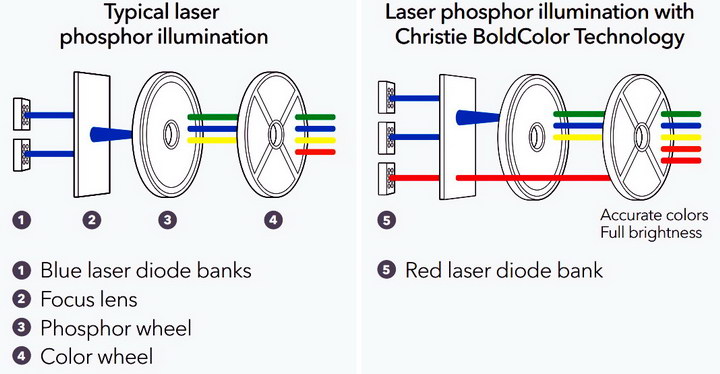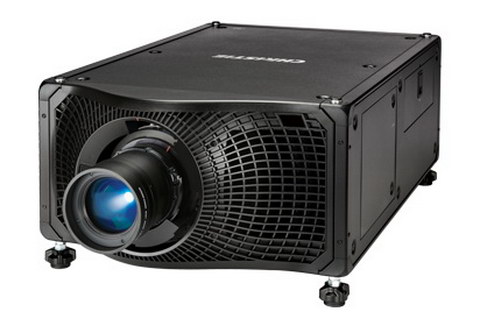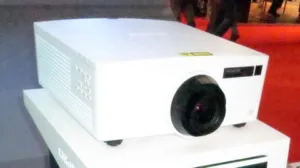Christie Digital introduced several new projectors at ISE, including the Boxer 4K20 and a series of single DLP laser-phosphor projectors that includes the DHD599-GS and the previously-announced DHD850-GS. In addition to these new products, Christie showed models from its L Series, Captiva Series, GS Series, HS Series, Mirage Series and Boxer Series. These projectors showed off the complete range of Christie projector technology, including 3DLP, 1DLP, 3LCD imaging systems and single lamp, multi-lamp, laser-phosphor and RGB laser illumination systems.
The new Christie DHD599-GS, which I was told was mainly an upgrade to the DHD555-GS, is a DLP projector with a single 0.65” DLP imager with FHD resolution (1920 x 1080). While the projector shown at ISE was FHD, the projector is also available in a WUXGA resolution. The FHD version of the projector has 5,625 ISO lumens or 5,000 ANSI lumens. In part, the high brightness is due to the use of an RGBW color wheel so the Color Light Output (CLO) lumens will be much smaller than the ISO or ANSI lumen values, adversely affecting the perceived colorimetry of the projector and making saturated colors appear dimmer than the content creator intended. Like virtually all single panel DLP projectors with a white color wheel segment, Christie does not cite CLO lumens, which would give end users and indication of the magnitude of this issue. The data sheet specifies five different contrast values from 1,500,000:1 to 250:1. The value of 1200:1 corresponds to the commonly accepted native contrast of the projector. The light source lifetime is 20,000 hours. Seven different zoom lenses are available, completely covering the throw ratio range from 0.75:1 to 5.5:1. Lens offset is ±60% vertical and ±15% horizontal. The projector targets boardrooms, higher education, houses of worship and smaller location-based entertainment venues.
Christie DHD599-GS at ISE
The Christie DHD850-GS was actually released in April, 2016. It is another laser phosphor single panel DLP projector using the same FHD 0.65” imager as the DHD599-GS. Unlike the DHD599-DS, this projector uses technology Christie calls “BoldColor.” Since previous reports on BoldColor in Display Daily did not explain what BoldColor Technology actually is, I’ll go into the details.
 Christie BoldColor Technology (Source: Christie Digital)
Christie BoldColor Technology (Source: Christie Digital)
BoldColor technology is shown in the image. On the left is a typical laser phosphor light source for a single panel DLP projector. It includes (1) one or more banks of blue laser diodes, (2) focusing optics to focus the blue laser beams onto as small a spot as feasible on (3) the phosphor wheel. Depending on the phosphor used, the phosphor converts the light to either green, yellow or red light. The Christie graphic shows the wheel creating both green and yellow light. Typically, the phosphor wheel would also have a clear segment (not shown) to allow the blue light from the laser to pass through unchanged. Finally, (4) there is a color wheel that filters the yellow light to both red and green, or trims the green and yellow colors produced by the phosphor. In an RGB projector, the color wheel will have three or a multiple of three segments while in a RGBY or RGBW projector, the color wheel will have four or a multiple of four segments. The three or four segments are typically not of equal size – sizes are adjusted to produce the target white point on the screen.
Initial discussions of Christie BoldColor technology indicated that the color wheel turned 3x as fast as a conventional color wheel, dramatically reducing color breakup in the projector. There is more to BoldColor than this, however. The technology includes the use of a separate bank of red lasers (5) to produce saturated red light. The Christie graphic shows this saturated red light mixing with less saturated red produced from the yellow phosphor to produce the red color on-screen. This mixing of the red and orange light to produce the red on-screen actually produces several desirable results. First, current red lasers produce red that is too saturated for most display systems, so mixing it with red with reduced saturation can produce exactly the color needed, for example, by a Rec. 2020 red. In addition, by mixing the red laser line emission with the broadband red from the phosphor, visual metamerism and speckle are reduced.
BoldColor sounds very similar to the Coretronic MCLA technology discussed in my Display Daily for February 22, 2017. Coretronic claims to have a patent on the MCLA technology and BoldColor technology is so similar to it, I would assume Christie sources either the optical engines or the complete projectors from Coretronic.
The Boxer 4K20, which was actually announced in late January, is a three panel 1.38” DLP projector with true 4K resolution (4096 x 2160). Lumen output is 19,500 ANSI, 20,000 center and 22,000 ISO lumens. It is powered by four 450W NSH mercury lamps, which have a lifetime of 1500 hours to 70% brightness. Two short throw lenses are available with 0.72:1 and 0.9:1 throw ratio, plus 7 zoom lenses covering the complete range from 1.13:1 to 7.69:1.
The Boxer 4K20 is very similar to its big brother the Boxer 4K30. The Boxer 4K20 uses the same 1.38” DLP imagers as the 4K30. The key difference between the Boxer 4K20 and 4K30 is the 4K30 uses six 450W NSH lamps instead of four. Like all the other projectors in the Boxer product line at Christie, the Boxer 4K20 specifically targets the rental and staging market with portability and ruggedness.
 Christie Boxer 4K20 (Source: Christie Digital)
Christie Boxer 4K20 (Source: Christie Digital)
Christie also showed a prototype of a single chip laser-phosphor projector with UHD resolution and 13K lumens. This is in development and has no official launch date. The Christie rep said that, hopefully, it will be released late this year but it might be next year.
They were also showing a 3-chip DLP, DCI-compliant, RGB laser projector. This differed from previous RGB laser cinema projectors in that it was fully integrated into a single unit. Previous projectors had been two or more units – the projector head, the lasers themselves and perhaps an external chiller for the lasers. This projector will have 20K lumen output, BT-2020 colorimetry and HDR. 6P 3D could be done by stacking two of these projectors. Release of the projector is planned for next year. Christie did not allow any photos to be taken of the projector. –Matthew Brennesholtz
Turning to flat panels, the company was highlighting its range of direct view LCD video wall displays which now includes a 55″ model (the FHD553-XE-H) which has a 1.7mm (combined) bezel. Brightness of the new model is 700 cd/m². The company has also updated its calibration and matching software.
The firm has also been developing its LED technology. Initially, the Velvet series was developed with a partner in China, but because of a number of practical issues, the company is now taking manufacture and development fully in house and will launch a new range under the Ultrascape name at the NAB show in April (although it could be deferred to Infocomm). Pixel pitch will be offered from 1.2mm. The product will be for installation purposes and was being previewed at ISE. As you would expect, it looked good.
The reseller market for A/V is always under pressure and to develop, resellers often need to start to get into and exploit the need for content creation. Christie is working on ways, for example toolkits, that can help resellers with this, giving them some help in moving away from the more commodity parts of the market. (BR)

